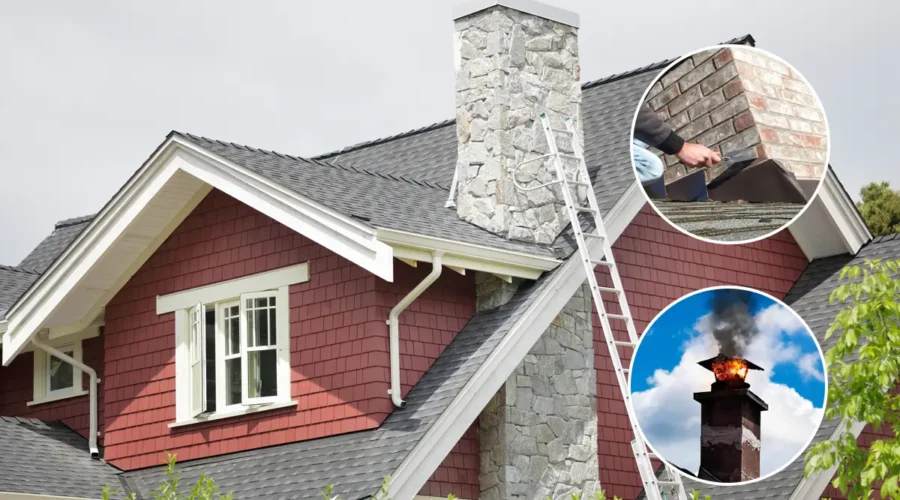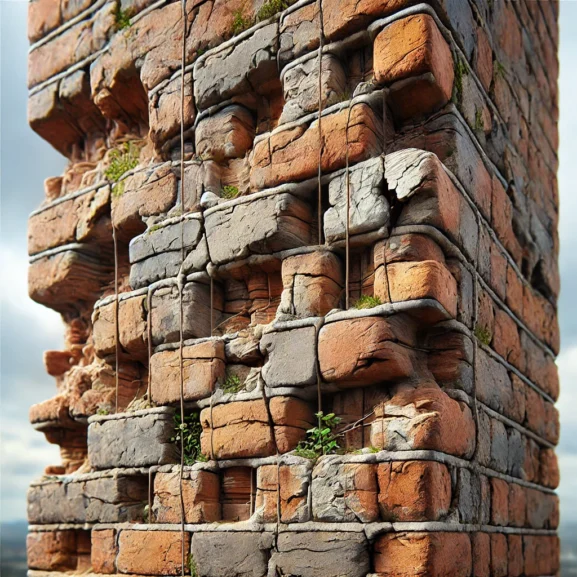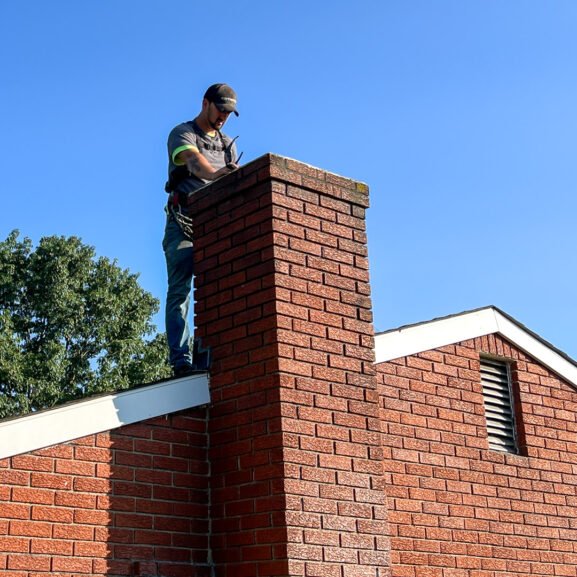Prevent Chimney Leaks Caused by Improper Siding Installation: Expert Tips & Solutions
Water intrusion, or what most homeowners often refer to as chimney leaks, is a very notorious issue. This clearly escalates to costly repairs and, in some cases, structural deformation. One of the most common reasons for such leaks is the poor installation of sidings on a house. Then again, when siding is incorrectly put up, it allows the creation of spaces or has inherent structural flaws. These allow water to enter, harming not only our chimneys but also our houses.
If improper siding installation leads to chimney leaks, then the signs will be discussed in this article we write. Learning this, we will be able to prevent it in the future and ensure our houses are watertight. What are some of the causes of these leaks and how can we can come up with measures that can prevent such incidences on our homes.
How to Identify and Fix Chimney Leaks: A Complete Guide
Chimney leaks always caused havoc to home interiors; they are common where there are siding problems. Knowledge of the causes and resolution can prevent expensive damage. Reach out to a professional for consultation.
Common Causes of Chimney Leaks
- Improper Siding: Gaps in siding allow moisture to penetrate, causing leaks. These gaps lead directly to water damage in homes.
- Chimney Flashing: Faulty or old flashing is a prime suspect for leaks. Regular checks are needed to ensure it’s sealed tight.
- Sealant Failure: When the sealant cracks, it’s a green light for water infiltration (Source: National Fire Protection Association).
Importance of Proper Siding Installation
It is therefore important that proper siding is installed in order to ensure adequate protection of your building. It helps prevent any water from accessing its space and makes your structure remain firm. As a result, the siding does not allow moisture to penetrate and wreak havoc as it would do it on other siding. This also means that expensive repairs in the future are well avoided. Over the years weather has become unpredictable hence pointing the right siding towards the climate is essential. But do not worry, for all such areas are explained in detail below. We work fast and efficiently as a team/organization. Yeah, do not refrain from laughing, they are quite trendy right now – the jokes about sidings!
For more tips and guidance on chimney maintenance, visit the Chimney Safety Institute of America. Always rely on professionals—we promise it’s not because we’re control freaks! Call us for expert advice.
Consequences of Improper Siding Installation

Inadequate siding may take your beautiful home and turn it into a wet nightmare. All sorts of chaos arise from siding gaps. Okay now let’s discuss how these troubles look like.
Water Damage and Structural Issues
Chimney leaks often stem from improper siding. Water infiltration through siding gaps wreaks havoc on both interiors and exteriors. Wall discoloration, mold, and timber rot are just a few results.
- Wall Damage: Siding gaps give water-free entry, staining, and weakening walls.
- Structural Threats: Moisture penetration can compromise the entire building envelope. Serious structural issues, such as frame warping, may arise (source: University of Minnesota Extension).
- Mold Growth: Damp areas are ideal for mold, which can harm health.
Are you worried about the siding sagging? Reach out to a professional for consultation.
Energy Efficiency Concerns
Beyond leaks, improper siding impacts energy efficiency. Misaligned siding messes up insulation, forcing heating systems to work overtime.
- Air Leaks: Gaps let warm or cool air escape, spiking energy bills.
- Poor Insulation: Siding issues often reduce home comfort by allowing drafts.
- HVAC Stress: Overworked heating and cooling systems mean increased maintenance and costs.
Due to temperature swings, efficient insulation is vital for homeowners. Using quality siding materials minimizes energy loss and improves weather resistance (source: Energy.gov).
Don’t let siding issues drain your wallet. Protect your home by contacting our experts.
Identifying Chimney Leaks
Chimney leaks often go unnoticed until significant water damage occurs. Recognizing the signs early can save money and prevent home exterior problems. Let’s explore the telltale signs and inspection procedures for chimney leaks.
Signs of a Chimney Leak
Spotting a chimney leak isn’t rocket science. Here are some signs to watch for:
- Water Stains: Brown stains on the walls or ceiling may mean water is leaking in from the chimney.
Moldy Odors: A musty smell can be a sign of moisture getting in, possibly through gaps in the siding.
Peeling paint near the fireplace: Peeling paint near the fireplace is a sign of trouble. If you see bubbling or peeling, it may mean there’s an issue with the siding installation. - Visible Cracks: Cracks in the chimney flashing or the brickwork can lead to leaks.
These signs may indicate improper siding or other issues, like sealant failure. Reach out to a professional for consultation.
Inspection Procedures
A thorough inspection is crucial to pinpoint the leak source. Here’s how we approach it:
- Visual Check: Look at the outside of the chimney. Check for cracks, gaps, or damage to the building.
- Flashlight Test: Shine a flashlight inside the chimney. Look for any water damage or issues with the masonry.
- Sealant Examination: Check the chimney’s seal for wear. This could lead to water getting in.
- Professional Tools: We use special equipment. It helps us find hidden problems and decide how to prevent leaks.
Preventing Chimney Leaks

Proper siding installation helps prevent chimney leaks. We also need to ensure your home stays dry and cozy, which is especially important given the unpredictable weather.
Best Practices for Siding Installation
- Quality Materials: Use strong siding materials to handle tough weather. This will help reduce gaps in the siding.
- Professional Installation: Hire professionals to ensure proper alignment and avoid siding installation issues. You wouldn’t want a leaky chimney because of crooked siding, would you?
- Flashing Integration: Ensure chimney flashing is correctly positioned to prevent water infiltration. Proper flashing is your chimney’s best friend.
- Regular Inspection: Inspect your siding regularly, especially after storms. This helps catch problems early. Think of it like a check-up for your house.
Read more about fire safety and protection from reputable sources.
- Sealant Check: Check your chimney’s sealant regularly to prevent failure. Without proper sealant, water damage can occur.
Routine Cleaning: Keep the chimney area clean. Remove debris regularly. Debris can lead to moisture penetration. - Proactive Repairs: Address any siding gaps promptly to maintain a solid building envelope. Remember, a stitch in time saves nine!
- Annual Inspection: We recommend scheduling a professional inspection every year. This helps catch leaks and other exterior problems early. Regular checks can prevent bigger issues down the line.
Want to prevent leaks? Reach out to a professional for consultation. For expert guidance, explore more on chimney maintenance.
Repairing Chimney Leaks
Chimney leaks can cause serious damage to your home. If not fixed, they can lead to water damage and structural problems. Knowing when to call a professional can protect your home from these issues.
When to Call a Professional
Professional help is essential when chimney leaks continue after initial repairs. Experts can quickly spot issues like sealant failure or poor siding, which can let moisture in. Look out for signs like water stains, moldy smells, or gaps in the siding. If you see these, it’s time to take action.
We recommend not handling these repairs on your own. Major problems need special tools and expertise. If issues keep coming back, it’s best to call the experts. DIY repairs could make things worse and turn your chimney into a mess!
Schedule a free consultation with a professional to ensure your home stays dry and safe, especially with unpredictable weather conditions. For more safety tips, refer to resources from trusted safety organizations, this fire safety guide and this home maintenance checklist.
Conclusion
It is important to prevent chimneys from leaking and that is why repairing chimneys damaged by improper siding installation is important in protecting our homes. Fig. 11 Sustainable development goals It is useful in maintaining our safety and enhances energy utilization. If the siding is improperly installed, then water can seep into the chimney as well, explains S. This may cause damage to the car as well as high heating cost. Correcting these leaks will save problems in the future as they should have been solved earlier. If we do not act as soon as we notice cracks, we will end up suffering from massive losses. Understanding that damaged siding can be problematic helps us do something about it. Hence we get to protect our homes when we act fast. Correct inspection and advice from professionals should enable us prevent costly calamities. They also prevent water from freely entering our homes and help create a warm environments. We have to select high-quality supplies. Issues can arise from time to time, and it’s important to reach out to trusted professionals for help. If you’re in a dilemma, many experts offer free consultation services and reliable solutions that work.
Frequently Asked Questions
What are the common causes of chimney leaks?
Common causes of chimney leaks include poor siding installation, damaged chimney flashing, and sealant failure. These issues can allow water to enter your chimney and cause damage. Proper installation and maintenance are key to preventing leaks. These problems can let water in. Water infiltration can cause structural damage. It can also increase repair costs. It’s important to find and fix these issues early. This helps prevent more damage later.
How can improper siding lead to chimney leaks?
Improperly installed siding can create gaps. These gaps let water in and seep into the chimney area. When this happens, the building envelope is compromised. Moisture can penetrate, causing structural problems. It can also lead to other issues, like mold growth.
What are the warning signs of a chimney leak?
Signs of a chimney leak are easy to spot. Look for water stains, moldy smells, peeling paint, and cracks. A thorough inspection is important. Check visually and use professional tools. This helps find problems before they cause major damage.
Why is proper siding installation crucial?
Proper siding installation is key to stopping water from getting inside your home. It helps keep your building strong and secure. When done right, it lowers the chance of leaks. It also helps your home handle the weather better. This is especially important in places where the temperatures can change a lot.
How can homeowners prevent chimney leaks?
To prevent chimney leaks, we should use quality materials, ensure professional installation, and ensure proper flashing. Regular inspections are key to spotting problems early. If there are gaps or sealant issues, we need to address them quickly. This will help keep our home in good condition.
Why is it important to get a professional inspection?
Professional inspections help find hidden problems early, preventing costly damage and keeping your home safe and dry. We recommend having inspections every year, especially in areas with unpredictable weather. Regular checks help maintain your home’s condition and comfort.
When should homeowners call a professional for chimney repairs?
If you’re dealing with problems like water stains or moldy smells, it’s best to get expert help. DIY fixes can sometimes make things worse. Reach out to a trusted professional for a free consultation. They can help resolve the issue safely and effectively.
How do chimney leaks affect energy efficiency?
Chimney leaks often happen because the siding is misaligned. These leaks can cause air to escape, reducing energy efficiency and leading to higher energy bills. HVAC systems also become stressed. To prevent this, it’s important to use quality materials and proper installation practices, which will help improve weather resistance.


